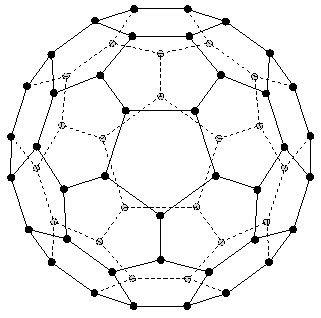|
Home
Courses
|
Description of course: Abstract Algebra is the study of mathematical structures carrying notions of "multiplication" and/or "addition." Though the rules governing these structures seem familiar from our previous middle and high school training in algebra, they can manifest themselves in a beautiful variety of surprising ways. The notion of a group, a structure carrying only multiplication, has its origins in the classical study of roots of polynomial equations and in the study of symmetries of geometrical objects like platonic solids. Today, group theory plays a role in almost all aspects of higher mathematics and has important applications in chemistry, computer science, materials science, physics, and in the modern theory of communications security. The main topics covered will be (finite) group theory, homomorphisms and isomorphism theorems, subgroups and quotient groups, group actions, the Sylow theorems, ring theory, ideals and quotient rings, Euclidean domains, principle ideal domains, and unique factorization domains. Time permitting, we will investigate topics such as public key cryptography systems such as RSA. This will be a heavily proof-based course with homework requiring a significant investment of time and thought. The course is a must for all students planning to study higher mathematics, and would be helpful for those considering entering subjects such as computer science and theoretical physics. Expected background: The official prerequisite is linear algebra, either Math 22 or 24, with Math 24 generally providing a better preparation. But in reality, all that is required is a mature mathematical mind, some experience with/interest in writing proofs, and the desire to work incredibly hard.
Work with anyone on solving your homework problems,Writing up the final draft is as important a process as figuring out the problems on scratch paper with your friends, see the guidelines below. If you work with people or external resources, you must list your collaborators and sources on the top of the first page. This makes the process fun, transparent, and honest. External resources: Mathematical writing is very idiosyncratic; if your proofs are copied, it is easy to tell. You will not learn (nor adhere to the Honor Principle) by copying solutions from others, or from external sources such as internet forums and generative artificial intelligence (GAI) output. Concerning internet forums (e.g., math.stackexchange), you are free to look at them and use any understanding you've gained from them in your course work, of course, subject to the above rules. Just be warned that these forums often contain incorrect or circuitous solutions, misleading discussions, use of techniques outside of the course material, and other material that may be detrimental to your learning process. Even the time that it takes to repeatedly search for solutions and read through dozens of forum posts could be better spent learning the material on your own or composing a question via email to me. Concerning GAI (e.g., ChatGPT), you are free to experiment with asking questions, but be warned that these systems are currently still very bad at deductive reasoning, and that the output may contain a mix of correct, incorrect, and unverified statements. Ask them to prove something false, they will work hard to do so, often giving contradictory answers. Therefore, I would be very careful with using these tools as learning resources on your own. There will be some scaffolded problem set problems that will involve engagement with these tools. Attendance: You are expected to attend class, including required X-hour sessions, in person unless you have made alternative arrangements due to illness, medical reasons, or the need to isolate due to COVID-19. For the health and safety of our class community, please follow Dartmouth's health guidance. Accommodations: Students requesting disability-related accommodations and services for this course are required to register with Student Accessibility Services and to request that an accommodation email be sent to me in advance of the need for an accommodation. Then, students should follow-up with me to determine relevant details such as what role SAS or its Testing Center may play in accommodation implementation. This process works best for everyone when completed as early in the term as possible. If students have questions about whether they are eligible for accommodations or have concerns about the implementation of their accommodations, they should contact the SAS office. All inquiries and discussions will remain confidential. Additional notesX-hour: In the first few weeks of the term, the X-hour will consist of a required introduction to set theory, logic, and proof writing conducted by TA Lily McBeath. After that, it will generally revert to office hours or midterm review, and occasionally will serve another purpose (e.g., extra or make-up lecture time) that will be announced in advance. Homework: Weekly homework will be due on Wednesday by 5 pm on Canvas. Each assignment will be posted on the syllabus page the week before it's due. Late or improperly submitted homework will not be accepted. If you know in advance that you will be unable to submit your homework at the correct time and place, you must make special arrangements ahead of time. In general, even if you haven't completed all the homework problems for the week, it is advisable to hand in what you have. In keeping with the guidelines below, it is advisable to hand in a selection of problems with complete solutions rather than shaky and poorly written-up solutions to all the problems. You might consider taking the opportunity to learn LaTeX. Otherwise, you can write out your solutions, neatly and straight across the page, on clean paper, with nice margins, scan them, and upload them. Your lowest homework score above 50% from the term will be dropped. Exams: There will be two take-home midterm exams and an in-class final exam on Monday, November 20, 3:00 - 6:00 pm in Kemeny 105. Homework guidelines: Generally, a homework problem in any math course will consist of two parts: the creative part and the write-up.
|
|||||||||||||||||||||||||||||||||||||||||||||||||||||
|
Home Courses |
